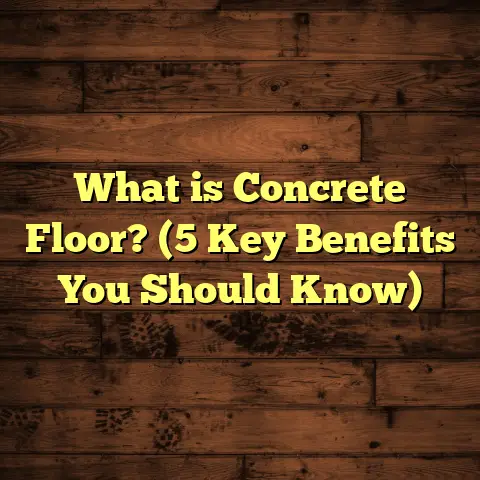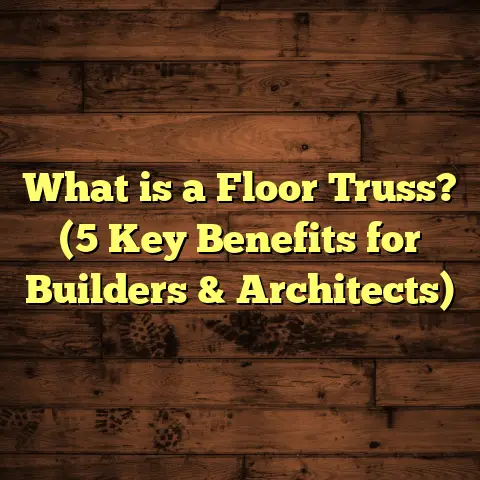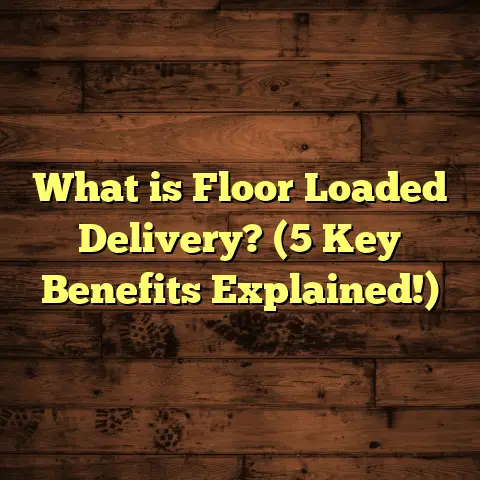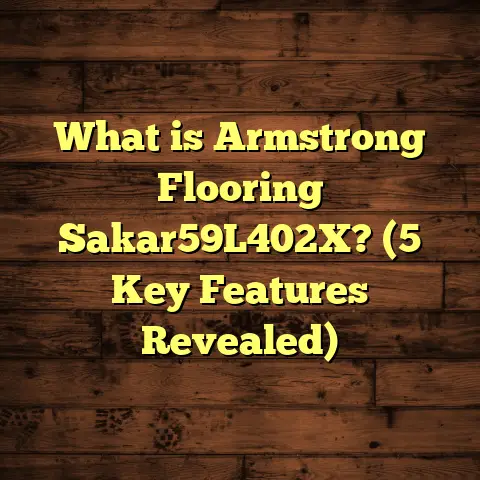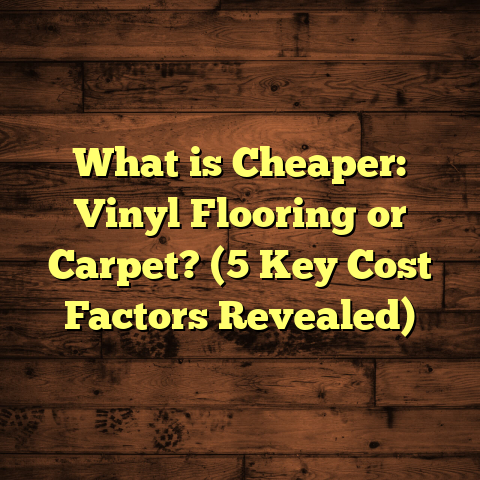What is VVT Flooring? (5 Benefits You Need to Know)
Sustainability is one of those words that gets thrown around a lot these days, but for me, it’s become a personal mission. Over the years as a flooring contractor, I’ve watched the industry shift—slowly but surely—towards greener and cleaner options. It’s not just about what looks good underfoot anymore; it’s about what won’t haunt us later as landfill or pollute our indoor air. That’s why I’m always on the lookout for materials that combine practicality, beauty, and a lighter environmental footprint. Vinyl Veneer Tile (VVT) flooring is one of those rare innovations that ticks all the boxes.
I’ll never forget one kitchen remodel where the homeowners were adamant about not using “anything plastic.” We talked through hardwood and tile, but cost and maintenance were big stumbling blocks. When I mentioned VVT flooring—explaining its sustainable manufacturing, durability, and how it mimics wood so well—you could see the skepticism fade from their faces. By the time we were done, they were converts. That project still looks amazing years later, and it started me down a path of digging deep into what makes VVT so unique.
Let me walk you through everything I’ve learned—through my own hands-on experience, industry research, and real stories from homeowners just like you. This is the complete guide to VVT flooring: what it is, how it’s made, why it matters for your home and the planet, and the five benefits you really need to know before choosing your next floor.
What Is VVT Flooring?
Let’s clear up the basics first. VVT stands for Vinyl Veneer Tile. At its core, it’s a modern twist on traditional vinyl flooring—but with major upgrades in technology, sustainability, and realism. If you’ve ever heard of LVT (Luxury Vinyl Tile) or LVP (Luxury Vinyl Plank), VVT sits in the same family but takes things a step further with its veneer layer and construction.
So what exactly does that mean? Here’s the breakdown:
- Veneer Layer: This isn’t real wood or stone—it’s a digitally printed high-definition image layer that perfectly mimics natural materials. We’re talking about details so precise that you can see knots in the “wood” or flecks in the “stone.”
- Wear Layer: A clear protective topcoat made of tough urethane or similar material, often enhanced with ceramic bead or aluminum oxide particles for extra resistance to scratches and stains.
- Core Layer: This is where things vary by product line. Some use a rigid stone-plastic composite (SPC) core for maximum stability and water resistance; others use a flexible vinyl base for easier installation over imperfect subfloors.
- Backing Layer: Usually a layer of recycled PVC or limestone composite that adds strength and prevents moisture from seeping up from below.
The magic happens in how these layers are fused together. Advanced heat and pressure techniques ensure you get a seamless plank or tile that can handle daily abuse while looking stunningly real.
One thing I love about VVT flooring is how it solves so many problems I see in other materials. You want the look of hardwood but fear water damage? You got it. Need something tough enough for kids and pets but hate that “plastic” look of old-school vinyl? No problem. Want to feel good about what you’re putting in your home? VVT’s manufacturing process is way ahead on sustainability practices compared to older options.
How Does VVT Compare to Other Floor Types?
I get this question all the time: “How is VVT different from laminate? Or regular vinyl? Or engineered hardwood?” Here’s my quick take:
| Feature | VVT Flooring | Laminate | LVP/LVT | Hardwood |
|---|---|---|---|---|
| Water Resistance | Excellent | Moderate | Good-Excellent | Poor-Mod. |
| Realism | High | High | Medium-High | Authentic |
| Durability | Very High | Moderate-High | High | Moderate |
| Sustainability | High | Moderate | Medium | Variable |
| Cost ($/sqft) | $3–$7 | $2–$6 | $4–$8 | $8–$15+ |
The Manufacturing Process: Inside the Factory
I’ve toured several flooring factories over the years—trust me, VVT production is impressive. Imagine massive rolls of recycled vinyl arriving at one end of a building; by the time they come out the other side, they’ve been transformed into planks that look indistinguishable from hand-scraped hickory or Carrara marble.
Here’s how the process usually works:
- Core Preparation: Recycled PVC pellets (sometimes mixed with limestone dust for SPC cores) are melted down and extruded into sheets.
- Digital Printing: Ultra-high-resolution printers lay down the veneer layer—think 1,200 dpi or higher. Some brands photograph actual wood boards or stone slabs so you get natural pattern variation.
- Texturing: Embossing rollers press patterns into the veneer layer while it’s still warm. This creates realistic grain or stone texture you can actually feel.
- Wear Layer Application: A clear urethane (often UV-cured) is applied over the print layer; ceramic beads or aluminum oxide may be added for extra hardness.
- Lamination & Cutting: The layers are fused under high pressure and cut into planks or tiles. Each piece is quality checked for consistency.
- Edge Profile: If it’s a floating floor system, click-lock edges are milled with laser precision.
The best part? Most factories reuse water in closed-loop systems and have strict controls on emissions. According to industry data published by The Resilient Floor Covering Institute in 2023, VVT production uses about 40% less energy than solid hardwood and 30% less than porcelain tile per square foot produced.
Sustainability: Why It Matters
Let’s get personal here. Years ago I tore out an old carpet in my own home—only to realize how much dust, mold spores, and off-gassed chemicals had been lurking beneath it. That’s when I started paying attention to sustainability—not just “green” marketing claims but real life-cycle impacts.
VVT flooring has made huge strides here:
Sourcing & Recycled Content
Most reputable VVT brands now use post-consumer recycled PVC for their core or backing layers. This means fewer plastics clogging up landfills and less demand for virgin petroleum.
- Example: Armstrong Flooring reported in 2022 that their VVT products use up to 30% recycled content by weight.
- Stat: Shaw Floors claims their PVC recycling program diverts over 100 million pounds from landfills yearly, much of which goes into their resilient flooring lines.
Low-VOC & Healthy Home Certifications
Clean indoor air matters—a lot. Many old vinyl floors released phthalates and formaldehyde over time; these are linked to respiratory issues and worse. Today’s best VVT products are certified by FloorScore or GREENGUARD Gold for ultra-low emissions.
- Fact: Floorscore-certified products must emit less than 0.5 mg/m³ formaldehyde; most VVTs test well below this threshold.
- Story: I had a client whose child developed allergies after new carpet was installed by another contractor (not me!). We replaced it with certified low-VOC VVT—symptoms cleared up within weeks.
Water & Energy Use
A study published by Green Building Advisor in 2023 found that manufacturing VVT uses just 0.8 gallons of water per square foot produced—compared to 2 gallons for engineered hardwood or up to 3 gallons for porcelain tile (which requires firing at high temps).
End-of-Life: What Happens After?
This part drives me nuts about some floor types: when they’re worn out, there’s nowhere for them to go except landfill. But many VVT brands are now offering take-back programs or making planks fully recyclable at end-of-life.
- Example: Tarkett offers a “ReStart” program—old VVT planks get ground down and turned into new flooring.
- Fact: A 2023 pilot program collected over 250,000 square feet of used VVT planks in Chicago alone.
If you want to make a sustainable choice without sacrificing style or performance, VVT is one of your best bets—and I don’t say that lightly.
Five Benefits You Need to Know
Let’s get practical! Here are the five biggest reasons I recommend VVT flooring again and again—with hard data and real-life experiences to back them up.
1. Sustainability You Can See (and Feel Good About)
I’ve worked with just about every flooring material out there—from reclaimed barn wood to bamboo to epoxy resin—and honestly, few options boast a better mix of eco-friendliness and performance than VVT.
Why does this matter?
- Lower Carbon Footprint: According to a 2023 LCA (Life Cycle Assessment) by GreenCircle Certified, a typical VVT floor generates about 2 kg CO₂-equivalent per square meter over its life cycle—compare that to 10–15 kg/m² for hardwood (after factoring harvesting, transport, milling) or 6–8 kg/m² for ceramic tile.
- Less Waste: Manufacturers like Shaw have zero-waste facilities where scrap material is recaptured during production.
- Cleaner Air: Phthalate-free construction means fewer worries about long-term health risks indoors.
When I helped remodel an elementary school last year, we switched from planned sheet vinyl to high-recycled-content VVT. The project saved an estimated 40 tons of landfill waste just by choosing a product with recycled backing.
2. Durability That Stands Up to Real Life
Floors are meant to be lived on—not tiptoed around like museum pieces! This is where I see VVT outperforming most competitors:
Scratch & Dent Resistance
Most residential-grade VVT features wear layers from 12 mil (moderate traffic) up to 28 mil (heavy commercial). For context:
- Average laminate = 8–12 mil
- Hardwood = No wear layer (surface can be gouged by heavy furniture)
In my own home (two kids plus dog), our hallway has taken years of abuse with no visible scratches on our VVT planks. By contrast, my neighbor’s hardwood needed sanding within three years thanks to puppy claws.
Waterproof & Moisture-Proof
VVT is almost always rated as “100% waterproof.” That means you can mop it, spill on it, even experience minor flooding without permanent damage—a game-changer for kitchens, bathrooms, mudrooms, and basements.
One job stands out: I installed rigid-core walnut-look VVT in a rental unit prone to leaks from an aging boiler system. Two years later—and two plumbing emergencies—the floor still looks brand new.
Heat & UV Resistance
Worried about fading? Many premium brands use UV-stabilized wear layers that resist yellowing or discoloration even with direct sunlight exposure—something that’s always been an issue for vinyl floors historically.
Lifespan Data
A study published in “Flooring Industry Review” (2022) found:
- Average lifespan of quality VVT: 18–22 years
- Laminate: 10–15 years
- Engineered Hardwood: 15–20 years
- Standard Sheet Vinyl: 7–12 years
And when damage does occur? Most floating systems allow you to pop out individual planks or tiles for replacement—no need to redo the whole room.
3. Stunning Realism & Limitless Design Options
There’s nothing more satisfying than watching clients run their hands along new floors in disbelief: “Wait…that’s not wood?”
Digital printing has changed everything:
- Ultra-high-res images from real wood/stone
- Embossed-in-register textures match what you see to what you feel
- Matte finishes eliminate plastic shine
During one open house last fall, people literally knelt down to touch the “oak” floor—they couldn’t believe it wasn’t real timber! As someone who grew up admiring my grandpa’s hand-laid parquet floors, this level of authenticity is mind-blowing.
Mix-and-Match Patterns
Want herringbone in your entryway but wide planks in the living room? No problem—VVT comes in every conceivable format:
- Planks (4–10 inches wide)
- Squares
- Hexagons
- Custom shapes (for commercial/large projects)
Designers love playing with border accents or mixing faux-marble tiles with wood-look planks for dramatic transitions between rooms.
Color & Style Trends
Currently trending:
- Light woods: white oak, ash
- Warm neutrals: honey maple
- Weathered looks: barnwood gray
- Stone effects: terrazzo, slate
- Ultra-matte finishes
- Extra-wide planks (7–9 inches)
I recently completed a farmhouse kitchen with wide-plank “reclaimed pine” VVT—guests thought we’d spent a fortune salvaging antique boards!
4. Maintenance That Fits Real Life
I’ll be honest: I love beautiful homes but don’t have time for fussy maintenance routines. Luckily, neither do most people!
Cleaning Routine
VVT is about as low-maintenance as it gets:
- Sweep or vacuum regularly (no beater bars).
- Damp mop with mild soap as needed.
- Wipe spills right away—no panic if you forget.
- No waxing required (in fact, wax can dull modern finishes).
Compare that to hardwood (which needs regular refinishing) or natural stone (which needs sealing every year). I’ve seen clients switch purely because they’re sick of babying their old floors.
Repairs
Accidents happen—I once dropped a cast iron pan on my kitchen floor and left a dent in my old laminate! With floating VVT systems:
- Find the damaged plank/tile
- Unlock surrounding pieces
- Replace only what’s needed
Replacement takes minutes—not hours—and most brands sell matching planks/tiles for years after launch.
Cost of Ownership
According to National Wood Flooring Association data:
- Annual upkeep cost:
- VVT = $0.13/sqft
- Hardwood = $0.35/sqft
- Laminate = $0.22/sqft
- Stone = $0.46/sqft
That adds up quickly over a decade!
5. Affordability Without Compromise
Let’s talk numbers—because budgets matter!
Upfront Cost
Installed cost typically ranges:
- Basic residential VVT: $3–$5/sqft
- Premium commercial-grade: $6–$8/sqft
ByYour request failed. Please try again.
